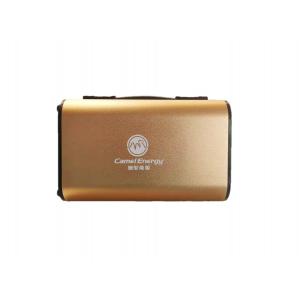

Add to Cart
Lithium-ion Battery Portable Energy Power Supply For Outdoor
Camping
Camping is becoming more and more popular. During the weekend or
the holiday, the families or friends will prefer to go camping
outside to enjoy the leisure time, breath the fresh air, and
observe the stars during the night. And then one portable power
bank for camping is very important. You can use it to provide the
power for lighting, cooking, music, mobile and emergency backup,
etc. One good-quality camping battery will make your journey safer
and happier. Now we have several models for your selection.
Product Features
Durable and Safe
Portable energy storage is the latest technology in modern mobile
devices. We made the PES200-A01 portable battery pack with a
non-flammable case to make the battery pack more durable and safer,
providing users with a reliable product to meet their needs.
Over Charging/Discharging Protection
Overcharge/overdischarge protection provides better protection for
safety during charging.
Intelligent Temperature Control and Effectively Heat Dissipation
Intelligent temperature control, effective heat dissipation,
perfect protection, avoid overheating, and reduce charging time.
Longer Service Life
The battery’s optimized design will extend its lifespan while
minimizing battery damage and adding safety measures to prevent it
from exploding or breaking due to heat.
Smaller Volume for Convenient Carry
The PES500-A01 is lightweight so you can easily take it anywhere at
any time.
Product Model
| Total Capacity | 512Wh |
| Cell Capacity | 4000mAh |
| Total Battery Cells | 40pcs |
| Inverter (Simulated/Pure Sine Wave) | Pure Sine Wave |
| Inverter(Max Output Power) | 500W |
| Inverter(Voltage) | 120V-60Hz |
| Output Port(AC) | *2 |
| Output Port(USB-A) | 2*(5V/2.4A) |
| Output Port(USB-C) | 2*PD 60W&5V3A |
| Output Port(12V Car Port) | 10A Max |
| Input Port(DC 8mm) | 12-30V 3.5A; Charger:25.2V/3.5A |
Applications
It's suitable for the people who travels a lot and camps outside.
About Camel
Founded in 1980, Camel Group Co., Ltd.(Stock No: SH601311) is
specialized in the R&D, production and sales of lead-acid
batteries, with the production of EV lithium-ion battery and used
battery recycling as the supplement. Camel is the largest and
leading car battery manufacturer in Asia.
Currently, Camel has four major brands, which are CAMEL, HUAZHONG,
SWAN, DF. With over 400 types of products covering automotive
starter battery, start-stop battery, lithium-ion battery, traction
battery, etc. Camel batteries are widely used in cars, trucks,
agricultural vehicles, golf carts, electric vehicles and other
applications.
The core competitiveness of Camel Group stems from continuous
independent innovation, clear development strategy and efficient
execution, which are all based on having an enterprising and
innovative management and technical team. To ensure the
technological leadership in the industry, Camel has continuously
increased R&D investment and introduced the world's leading
automatic production lines, and advanced R&D and testing
devices. The professional R&D institute under the company is
recognized as state-level enterprise technology center. Camel also
has academician expert workstation and state-level laboratory. As a
high-tech enterprise supported by the state, Camel has entered the
field of new energy vehicle prospectively, committed to green
energy manufacturing and recycling, and opening a low-carbon life
for mankind.
FAQ
1. Why is the battery voltage abnormal?
A: After charging, the voltage of each single cell should be around
2.1 V (may be affected by electrolyte density). If the voltage is
low during primary usage, check if battery is fully charged or if
electrolyte density is too high or too low.
If battery shows comparatively higher voltage during charging,
along with numerous bubbles and voltage drops fast during
discharge, this may indicate plates sulfation. Fully discharge the
battery with low current and then charge the battery with low
current (0.1C20), repeat the discharge and charge steps several
times. The effect of this method may be affected by the sulfation
degree.
2. What is the effect of abnormal electrolyte density and indicator
color?
A: During battery charging and discharging processes, electrolyte
density should vary from 1.070 to 1.290g/cm3. Density increases
during charging and decreases when discharging.
a. If density is too high, it will cause plate sulfation and
accelerate grid corrosion; while if density is too low, it will
affect discharge capacity.
b. Under normal charging conditions, if the density does not
increase significantly or even remain unchanged, there is a
possibility of plate’s sulfation, which may need countermeasures to
eliminate sulfation.
c. After the battery is charged, if the density decreases
significantly during the resting period, it indicates the sever
battery self-discharge, which may be caused by too much impurities
in electrolyte. If electrolyte shows abnormal color or smell, or
even shows turbidity, it indicates that the electrolyte is impure
and impurities has got into the battery.
d. If electrolyte shows the color of metal ions, there is a
possibility of contamination.
